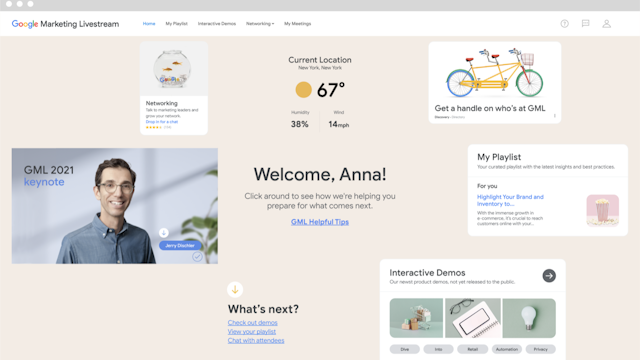WTF is a hybrid event anyway? The new challenges & opportunities for events
Virtual events proved their worth during lockdown. Now with more and more live events looming on the horizon, marketers are spending a lot of time talking about a hybrid approach. But what exactly is a hybrid event? And what will it take for marketers to succeed as expectations grow for both live and virtual interactions? Here’s what you need to know.

Live events are great for networking, but is a hybrid event the ultimate win?
Hybrid events are all the rage. But with no clear definition, high expectations and big budgets at stake, it’s an unprecedented moment for marketers and the events business as a whole.
The general consensus appears to be that live events will return with a larger focus on virtual audiences as well. The formulas for creating such activations are being hatched up as we speak. “There is no hybrid event in a box, no magical thing,” says Natalia Rybicka, senior director of event marketing at Attentive Mobile. “Hybrid, before the pandemic, was just livestreaming your event. Now people are talking about it in this really high-level way, but nobody has defined what that means.”
One thing that people agree upon is that virtual events and webinars proved their worth as the world lived under lockdown. The number of webinars grew 162% last year with attendance up 251%, according to the On24 Webinar Benchmarks report, which looked at 100,000 events/webinars with more than 100 people from 2,000 companies. There were 61 million events viewed and, even as we open up, 59% of respondents say they plan to increase the number of webinars this year.
Of course, On24 is a platform that enables digital events and platforms, so it’s not surprising it would publish such bullish numbers. Yet the stats do offer an indication as to how pervasive virtual events have become. “People will slowly dip their toe into live events on a smaller scale, but virtual events will continue to be popular because we’ve discovered a way to reach a really large audience,” says Rybicka. “With a live event, you just can’t do that.”
No matter what the pace of adoption of live versus virtual or both, event organizers say there is no going back to the old ways. For example, The 4A’s is planning a hybrid approach to Decisions 2022 and is looking to shift gears for the conference permanently. “We’ve moved to a place where you will no longer have in-person only,” says Marla Kaplowitz, president and chief exec at The 4A’s. “There will always be some sort of livestream component where you can attend virtually or attend remotely to catch up on content.”
Nikki Garvey, head of ads and YouTube events and experiences at Google, likens what’s happening in the event space to what happened to traditional television. “Just as streaming services started to make content available anywhere, anytime, the digitization of events has allowed for an attendee to consume parts of an event experience in their own time. There is so much choice and agency in an attendee’s experience. That will remain true as we return to hybrid and in-person events. People want to be able to have a more active role in their agendas, so our approach to content in real life will need to adapt.”
What hybrid looks like now and where it’s going
There is a brand new brief for event planners. It involves planning for two audiences: those attending live in-person and those sitting behind a screen. Making things even more complicated is that the content and experiences have to be equally compelling to both.
“What do these two kinds of simultaneous but equal experiences look like for both our in-person audience and our virtual audience? This changes and morphs the experience overall,” says Elena Klau, global chief strategy and analytics officer at Momentum Worldwide.
The key is to adopt the interactive virtual learnings from the past 16 months. American Express, for example, was famous for its live events directed at small business owners. That didn’t change when the world went virtual. Momentum created an immersive, 3D platform for them called American Express Campus. The end result: attendance tripled.
The allure of virtual events is clear. First off, it’s much cheaper to attend an event online since there are no travel costs and currently minimal conference fees. Plus there is no time wasted packing bags and booking flights. Logging on and off is quick and easy. The same holds true for when it comes to speaker recruitment. Top execs and talent are far more likely to sign on for an hour than go through the machinations of appearing live.
But aside from ease, innovation has also driven attendance forward. The American Express program leveraged avatars that can appear in one-on-one breakouts and take part in other personalized, interactive activities. “That’s the evolution,” says Klau. “It’s not just a static Zoom, log on for to two hours and listen. It has to be a two-way conversation. That is biggest shift between what was before Covid and now.”
For the YouTube Brandcast Upfront, Google delivered 3,500 customized shows to attendees, complete with a personalized at-home pizza kit based on selections made during registration. “Our number one priority has been to deliver hyper-relevant content to our audiences when and how they need it most,” says Garvey. “Most of our experiences have focused on personalization of the content journey – giving choice to the attendee on the topics they want to hear about and the insights most relevant to them, and delivering that to them in a succinct package.”
Moving forward, a hybrid event has to include participation, says Garvey. “For the digital and physical event space to come together you have to have participation from the online audience, and that’s where we’re focusing most of our thinking moving forward.”

Virtual wine tastings were nice, but there’s no replacement for in-person networking
Marketers and event planners exhibited Olympian efforts to entertain customers, prospects and employees. While they succeeded on many levels, they just could not replace the in-person, human-to-human experience.
“Our biggest learning is that there is no replacement for networking in real life,” says Google’s Garvey. “We have experimented with many formats and technologies, and while we’ve found some things that certainly work, they don’t work as well as interacting in person.”
While most can agree with that sentiment, how fast audiences return and at what scale remains to be seen. Mostly it will depend on the true purpose of the event, says Attentive Mobile’s Rybicka. “Events dedicated to networking should really be considered first for in-person, and education can stay virtual to get the most reach.” She anticipates brands starting “local and small”.
Amid the squishiness of what’s next lives budget considerations – especially in the B2B space, where events were one of the most important pre-pandemic tactics. “For B2B marketers, it’s about triangulating, ‘well, what did having only virtual experiences do for the velocity of our pipeline? How quickly did we close deals? How you fast can educate a potential buyer?’” says Jillian Ryan, eMarketer’s principal B2B analyst at Insider Intelligence. “If they figure that out and do attribution modeling with virtual events, they’ll be able to see how important it is to really go back to in person. Is it as soon as possible? Or maybe virtual is working and they could slowly figure out how we do these on a smaller scale with in-person experimentation.”
Then there’s the safety aspect of it all: social distancing, temperature checks, on-premise medical staff, highly-politicized mask mandates. All of these new production considerations come into play, says Ryan. “It’s not going to be how many people can we cram in.”
And the biggest pressure of all? Making certain this first live experience is stellar. “Many people are really happy with not living on planes the way they used to. I don’t see a return to business travel,” says Kaplowitz. “So if you are going to go in person, I think it’s going to have to be very well chosen and purpose-oriented.”
Ryan agrees: “The experience has to be special, curated and fun. There needs to be high-value customers, or really exclusive content, because if it’s something that someone can just get through a virtual event, then what’s going to make them want to go in person?”
You worked so hard to get that digital audience, so don’t lose them
One of the biggest fears for some is having to balance both the live and the virtual. The demanding aspects of putting on a live event – all of the moving pieces, malfunctioning equipment, speakers missing in action – can make the audience behind the screen seem less important.
Ignoring the virtual attendees could prove damaging. “If you take all the virtual events and try to make them live events, you’re really leaving this entire audience you’ve created over the last year behind and ripping the community from them,” says Rybicka. “It’s being cognizant of what we’re changing, and how those [virtual attendees] may feel about that.”
Momentum’s Klau says the hybrid event is about “reshaping”. There will be those large in-person moments, but the more immersive, virtual experiences can still offer something new and fresh. However, if they don’t, people will tune out. “We’re seeing a real fatigue with Zoom. People are eager to get back to live and brands need to be a part of it.”
But at the same time, Klau says the virtual side “can no longer just be a megaphone. It has to be an interactive experience. The two environments need to work together so your secondary audience can participate with your primary audience”.
And then there is the fact that no one actually has to do a hybrid event. Sometimes it’s fine to keep the physical and virtual worlds separate. “We’re being careful to assess what events need to be hybrid as we move forward,” says Garvey. “If ‘pivot’ was the event theme of 2020, ‘hybrid’ has become the new 2021 buzzword – but that’s not necessarily the answer for every event.”

